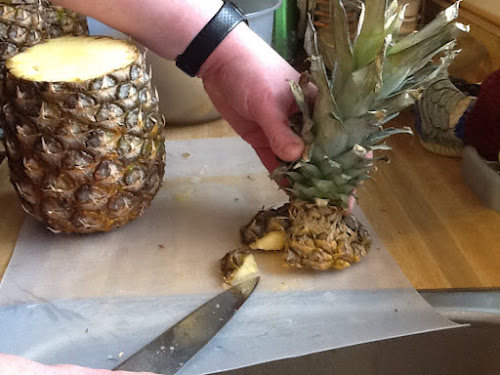It is a commonly accepted fact that virtually all drinks* are improved in both quality and presentation if they are served in a pineapple. Sipping your favourite beverage from the hollowed out recesses of the delectable fruit they call 'Nature's Candy' not only increases the average imbiber's state of relaxation by 2-8 milliDudes (mD), but can also provide enough citric acid and Vitamin C to stave off scurvy for brief periods of time.
Many are daunted at the prospect of transmogrifying a pineapple into a drinking receptacle, but it is, in truth, a relatively simple process. Due to the presence of sharp objects and the aforementioned acid, the likelihood of some degree of pain is fairly significant unless suitable protective equipment or cautionary practice are put into play. By following these basic instructions, you can partake of the potable of your choice in a manner both stylish and biodegradable!
Use a sharp implement to remove the top of the pineapple. Placement of the cut should be the highest point on the fruit before it tapers in toward the greenery. Ideally, a machete will be used for this,but if space or safety constraints make this implausible, a large serrated knife also works well. A chainsaw should not be used since it not only damages much of the edible fruit, it also wastes a considerable amount of juice.
Cut a notch in the top of the pineapple so that your straw will have ample access. A more precise opening can be obtained by using a drill or moto-tool, but this is not only impractical but also does not allow for lateral movement of the straw in order to stir or muddle the drink.
The only specialized tool required in this endeavour is a pineapple corer such as the one displayed above, obtainable from many grocery stores for less than $10. Even when not used for drinks, the corer makes it significantly easier to eat every subsequently purchased pineapple, which can only be a good thing.
Line up the corer with the eponymous portion of the pineapple, place some weight upon it, and twist the handle clockwise. The more pressure brought to bear upon the corer, the thicker the slices or rings of pineapple which result, which is why I, and not my wife, needed to preform this operation upon 8 pineapples for Glory's luau-themed birthday party this evening.
Care must be taken to insure that an inch or two of pineapple is left in the bottom, lest the structural integrity of the vessel be compromised, a tragedy typically proportional to the value of the liquid lost. For this reason, single malts are discouraged for drinking from pineapples, although blended whiskies are generally acceptable.
E

Removing the fruit from the hull of the pineapple can be a tricky bit of business, since a suction effect is often created during the coring process. Thankfully, removing the handle of the corer makes for easy removal of the fruit from the corer, simply by inverting it.
The screw design of the corer means the fruit comes out as a single coiled piece, which has a certain amount of both engineering and esthetic appeal, it is ultimately impractical and ill-suited for sharing. A single vertical cut will leave you with a stack of fresh pineapple rings, suitable for drink garnishing, general snacking or even grilling.
Despite its name, the corer leaves that part of the pineapple behind, so you will need to extract it. A serrated knife will allow you to slice it off at an angle close to the base. Care must be taken not to accidentally pierce the bottom of the pineapple, since this would undo the work done thus far.
The umbrella not only adds a certain degree of flourish, but also makes the lid a bit more stable. A regular toothpick can be used of course, but really, if it's too much trouble, maybe you ought to drink out of a red Solo cup instead, hmm?
In terms of content, my preference is for a mixture of ginger ale, fruit juice and silver or other light rum, but the possibilities are nearly endless. Enjoy this pleasant means of fending off scurvy!
* Exceptions include, but are not limited to, coffee, tea, certain flavours of milkshake (i.e. not pineapple) and porter.









No comments:
Post a Comment